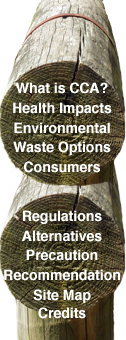Regulations
North America
In February 2002 the US EPA announced that manufacturers had agreed to voluntarily phase out the production of CCA-treated timber for residential uses over the following 2 years and in January 2004 the EPA would officially ban the manufacture of CCA-treated timber for residential use. Although the EPA had not completed its latest risk assessment of CCA at that time, it claimed that because arsenic was a known carcinogen ‘any reduction in the levels of potential exposure to arsenic is desirable’ (Office of Pesticide Programs 2002a). A similar voluntary phase out for non-industrial uses was instituted in Canada (CPSC 2003a: 8).
From December 31, 2003, ‘wood intended to be used in residential settings’ could not be treated with CCA in the US. This includes use in playground equipment, decks, picnic tables, landscaping timbers, residential fencing, patios, and walkways and boardwalks (US EPA, 2004a). However, this regulation does allow retailers to continue to sell, and for consumers to buy and use the wood, until stocks are depleted (US EPA, 2004b). It is calculated that this will reduce CCA-treated timber production in the US by around 80 percent (NSW EPA, 2003). A similar restriction applies to CCA-treated wood in Canada.
Although the US move away from CCA-treated timber in residential uses was supported by many concerned stakeholders, it is also criticized as not going far enough for some. Environmental groups who had been lobbying the EPA to ban CCA-treated timber immediately pointed out that the decision not only allowed continued sales of CCA-treated timber, but did nothing to deal with treated-timber already in the community. Older timber is just as likely to leach arsenic (Gray and Houlihan, 2002).
Belluck et al (2003) strongly criticize the US government failure to restrict public access in areas with high risks of arsenic contamination, which may include decking and playgrounds. They compare public spaces and residences containing arsenic-contaminated soils with hazardous waste sites, suggesting that there is an ‘incorrect presumption that a given level of arsenic in surface soils at a hazardous waste site somehow poses more risk than the same level at an equally contaminated residential/public space site’. Indeed, they remind readers that hazardous waste sites have controlled access through fences or covers, unlike public and residential areas. The authors note that hazardous waste sites are properly monitored and managed under statutes, while the ‘magnitude of [public and residential spaces] requiring investigation’ are unmanaged and provide open access to the public.
References:
Belluck, D., Benjamin, S., Baveye, P., Sampson, J., and Johnson, B. (2003), ‘Widespread Arsenic Contamination of Soils in Residential Areas and Public Spaces: An Emerging Regulatory or Medical Crisis?’, International Journal of Toxicology, 22, pp. 109:128.
CPSC (2003a), Fact Sheet: Chromated Copper Arsenate (CCA) -Treated Wood Used in Playground Equipment, U.S. Consumer Product Safety Commission, February 7, http://www.cpsc.gov, (accessed 16/8/04)
Gray, S. and Houlihan, J. (2002), All Hands on Deck, Washington, D.C.: Environmental Working Group (EWG). August. http://www.ewg.org/reports/allhand\sondeck
NSW DEC (2004), Extended Producer Responsibility Priority Statement, NSW Department of Environment and Conservation, http://www.epa.nsw.gov.au/resources/eprps2004.pdf (accessed 22/11/04).
Office of Pesticide Programs (2002a). ‘Manufacturers to Use New Wood Preservatives, Replacing Most Residential Uses of CCA.’ US Environmental Protection Agency (EPA). 12 February.
US EPA (2004a), ‘Guidance for Uses of Chromated Copper Arsenate (CCA), http://www.epa.gov (accessed 16/6/04).
US EPA (2004b), CCA Guidance- Questions and Answers, US Environmental Protection Agency website, http://www.epa.gov/pesticides/factsheets/chemicals, (accessed 17/6/04).


